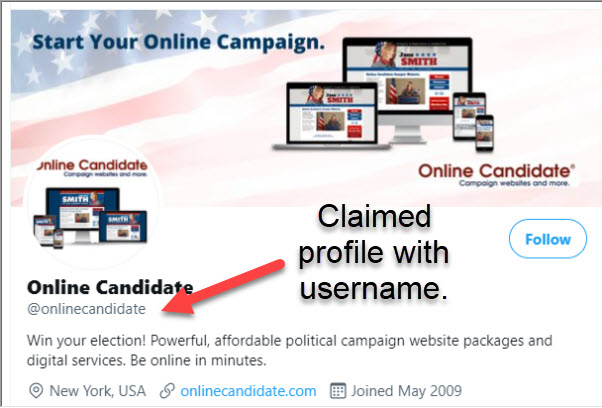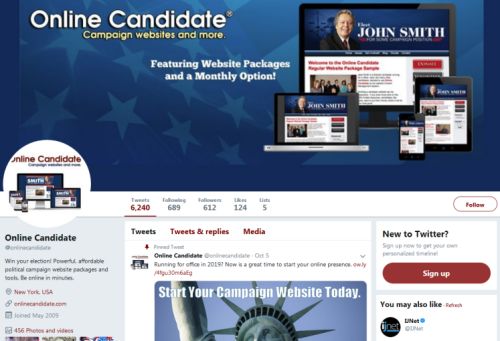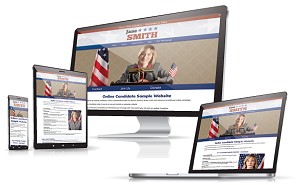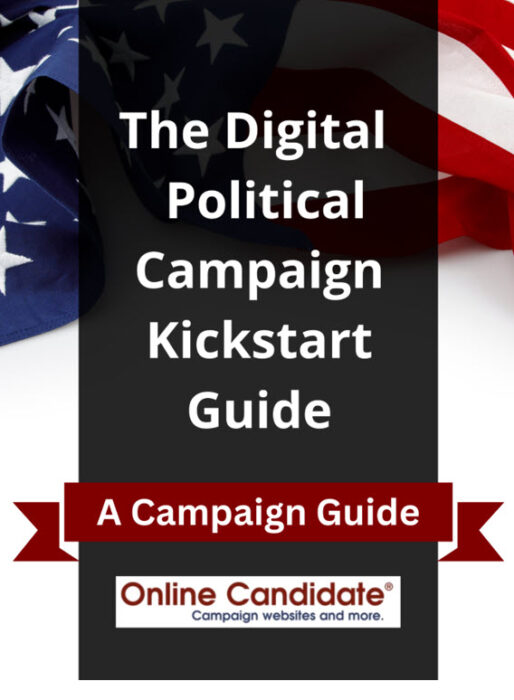X, formerly called Twitter, is a social messaging tool that presents great opportunities for political candidates to create branding, exposure and word-of-mouth advertising. It’s easy to set up and easy to use. Not only that, the service helps candidates save time and effort in communicating to the voter base.
Through Twitter, users can ‘follow’ others and others can follow them. It allows users to post status updates, or ‘tweets’, that are limited to 280 characters. These updates are communicated to followers, who can read, respond or even share the tweets with others.
Using X / Twitter for your political campaign:
- Claim @YourCampaign
- Modify your account settings and look
- Make updates regularly
- Build your following
- Is political advertising allowed on X?
- Don’t make these Twitter mistakes
- Twitter Tweet ideas for political campaigns and candidates

The big political X / Twitter tip – Claim @YourCampaign
Even if you don’t plan to use Twitter right away, be sure you claim your name or campaign name as your Twitter handle, even if you don’t intend to start using Twitter immediately. If you put it off, there’s a risk that your name could be taken by someone else, similar to domain name squatting.
Some candidates choose to use their existing personal account when they run for office. If you already have a Twitter account, you could use that one or create a brand new handle for your campaign. The advantage to using a variant of you name (@JoeSmith) rather than a year (@JoeSmith2021) or a position (@Smith4Mayor) is that the account won’t become outdated after an election.
Modify your account settings and look
Add your information and website link to the account settings. Brand your profile design by customizing the color settings and background. Use your campaign colors and logo to create a consistent look with your campaign website and other social media accounts.
Make regular updates and set up a post schedule
Even though your campaign may not have many resources for social media, keeping a campaign Twitter account up-to-date should not take much time. How often you post is less important than posting regularly, no matter what the schedule may be. Maintain momentum by posting on a daily or weekly schedule. Anything less than weekly, and you may start to lose followers.
See below for the section on campaign tweet ideas.
Post relevant news and content
Candidates don’t have to just post updates on what they are doing or thinking. Look at how other prominent politicians use Twitter for style and content ideas.
Political candidates and campaigns tend to post:
- News articles
- Campaign press releases
- Endorsements
- Website updates
- Event alerts
This material helps keep followers up to date. Don’t forget to add relevant images to draw more attention to your posts.
Pin a popular tweet to the top of your page. This might be a relevant tweet about your campaign or your most popular post. It should be something that would cause others to want to stay informed.
TIP: Try tweet-enhancing tools like Buffer. Use hashtags, retweets and shortened links to give variety to your posts. Be authentic in your tone and invite feedback. Some people may message you directly.
Build your following
In the beginning, you will use your personal contacts as your initial followers. Once you are up and running, Twitter will provide recommendations of others to follow. If you do this, some of these people will follow you back. This will help expose you to others who may be interested in following your campaign. Journalists and other media sources use Twitter to follow candidates, so be sure to follow them back.
You can also use X to connect one-on-one with supporters. It’s a great way to address immediate topics and concerns and really engage with others. Use it as a listening tool to learn more about voter moods, issue ideas and the latest news.
Tip: Leverage your other social media sites. Share your account in posts and updates, and ask your followers to also follow you on Twitter.
Make Twitter part of your larger online presence
Twitter is only one method of online communication. Your website, blog, Facebook and other social accounts should be kept up to date as well. Because Twitter is designed for ‘small bites’ of information, you can update your status far more frequently than you would on Facebook without annoying your followers.
Is political advertising allowed on X?
In 2019, Twitter suspended political advertising on its platform. In the days before that you could advertise to your state or district, but you needed a fairly large budget. Statewide or congressional campaigns were more likely have the ad budget to run ads. After the ability to run political ads ended, candidates focused on building follower engagement on other online advertising options.
In September 2023, Twitter/X allowed political advertising. It remained so through the 2024 election season. How long this will remain or how the rules will shift is anyone’s guess…
Don’t make these Twitter mistakes
Political candidates and campaigns have several reasons for using Twitter. They may want to build overall public exposure, establish branding, share ideas and information, and increase voter support. While Twitter is simple to set up and use, it’s not without its quirks. To attract and keep more followers, avoid these common mistakes.
- Sending tweets or posts from the wrong user account. Many people have multiple Twitter or X accounts. If you have a personal account and another for your political campaign, make sure you are logged into the proper account before you tweet. This mistake is more common than you may think, especially in the business world.
- Confusing a direct message with a general tweet. Former New York Representative Anthony Weiner learned the differences between a direct message and regular open tweet when a lewd photo was posted to his account. Make sure you know who you are sending your messages to. Never assume that any electronic communications are private or will remain so.
- Posting bad material. Keep an eye out on your Follower list and re-tweet relevant items. Don’t do it blindly, though. Make sure you check your sources. You don’t want to retweet false information.
- Being overly emotional. A little emotion in your posts is fine. After all, you don’t want to give the impression that you are a campaigning robot. On the other hand, too much complaining, vitriol and anger can backfire.
- The quality, not quantity, of your followers is important. You’re running to win an election, not a social media contest. Having a large number of follower doesn’t really matter if the bulk of your audience is fake.
- Not focusing on what works. Keep track of what produces the most shares, repost and engagement from your audience. Use this information to improve your outreach. It can help you grow your audience and even increase the amount of online donations you bring in.
Related: 5 Common Campaign Twitter Mistakes
Tweet ideas for political candidates
Starting up a Twitter account is easy, but it can tough keeping your tweets varied and engaging. For greater context and reach, your posts should include a related image or video.
Here are some campaign tweet ideas:
- Candidate comment on recent events regarding your state or district.
- Interesting or educational information related to a major campaign issue.
- Negative information about your opponent(s).
- Ask followers to stay current with your campaign by signing up for your email list.
- Reminders about an upcoming event – and why it will be great!
- Live Tweets during an event.
- Followup about a recent event.
- Latest poll numbers about you.
- Latest poll numbers about your opponent.
- Ask what issues are important to your followers.
- One sentence summary of your latest blog post, with link.
- Mentions of you in a news article.
- Location/district news, with comment.
- Support requests, usually related to another event.
- Volunteer requests, usually tied to a specific event or activity.
- Updates about campaign staff that may be of general interest.
- Fundraising goal status.
- Notification of new billboard/large banner location.
- Announcement that signs are available.
- Link to new video or campaign ad.
- Latest endorsement announcements.
- Shout outs to helpful individuals or organizations.
Related: X / Twitter Post Ideas for Political Candidates
Don’t forget to keep an eye out on your follower list and re-tweet relevant items with hashtags and usernames. Keep your updates varied and frequent. Your strategy should be to engage followers rather than simply broadcast to them.
For more information on getting your campaign started on X, visit the Political Content page.
Good luck and good tweeting!
Sign up to our email list below for more political and social media marketing tips and ideas.
« Tips For Designing Your Campaign Yard SignsHow Many Local Governments Are In The USA? (Infographic) »
Tags: twitter










